Haghia Sophia
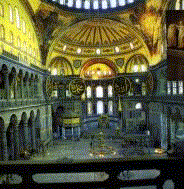 |
A
picture of the present-day interior of Haghia
Sophia. This large room is called the nave. |
History: The present-day building was erected
by the emperor Justinian and dedicated on December 26, 537
A.D. after a massive building project spanning 6 years and
costing 320,000 pounds of gold and the labors of 10,000
men. The dome atop the building is the largest in
the world, so two mathematicians were employed by
Justinian to help in its construction. The site had
housed 2 other churches previously, but both were
destroyed in massive fires due to riots in the city.
The name "Haghia Sophia" translates to
"Divine Wisdom" and was named so by Constanius,
the son of Constantine the Great. Over the years,
various earthquakes weakened the structure and caused
partial collapses of the dome, all of which were expeditiously
repaired. Many buttresses were also added on all sides of
the building for structural support.
Upon walking into the building, you will be marveled by
the attention to detail taken in the design. As the
historian Procopius put it: the dome seems to have no
solid foundation - it seems to be suspended by a
"golden chain from heaven." Windows are
placed so that the gold and silver of the ornate mosaics
and furnishings are suffused in light. Upon entering
the building, you will pass through two narrow entrance
halls, called narthexes, which are ornately decorated on
their ceilings and walls with marble panels and
mosaics. As elaborate as these halls are, neither
are as awe-inspiring as the nave, or main hall. This
huge space is very richly detailed with various colors of
marble, gold, silver, and numerous mosaics.
Hippodrome
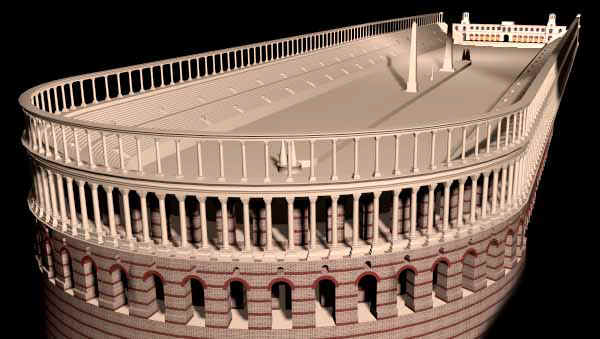 |
This
is a computer-derived animation of the Hippodrome. |
History: The original structure was built in
200 AD by Emperor Septimius Severus. When
Constantine the Great chose Constantinople (then Byzantium)
as his new capital, the arena was expanded and enlarged.
The Hippodrome is the focal point of social activities
in the city, just as Haghia Sophia is the focal point of
religious activities. Statues and columns decorate
the main arena and the exterior. The stadium can
seat over 100,000, and events such as chariot races and
circuses are presented regularly. If attending a
show, however, be careful, because fights and riots
frequently break out between rival groups.
Palace of Blachernae
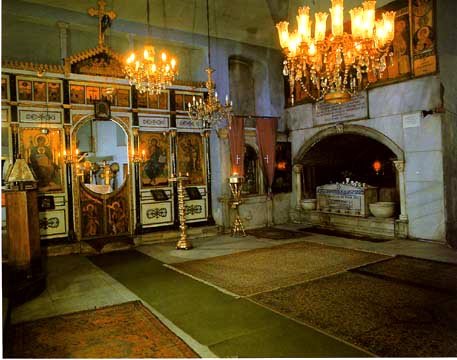 |
An
interior view of a room in the church connected to
the palace. |
History: This palace was built by Emperor
Anastasius around 500 AD, and has been used by the
imperial family ever since. Over the years, many additions
were added on to enlarge the building. The largest
additions and remodels came during the 11th and 12th
centuries during the reign of the Comneni Dynasty.
The magnificence of the palace greatly impressed the
Crusaders who took the city in 1204, and may have
heightened their desire to take the city for
themselves.
This is the main residence of the imperial
family. Although being granted an entrance is
extremely rare, one can see the incredibly elaborate
details on the outside of the buildings, as well as the
gardens, from a distance.
The Theodosian Walls
 |
This is
another computer simulation of what the walls
looked like from the outside. The moat,
outer walls, and guard towers can be seen. |
History: These great walls were first begun in
the 5th century under the reign of Theodosius II for
protection against invaders, who at that time were the
armies of Attila the Hun. When Constantine took
power, he extended the walls, made them stronger, and also
added a second outer wall and a moat, making them
virtually impregnable to attackers.
The Theodosian Walls are the primary defense for the
city against invaders. Consisting of an outer moat
and wall, and then the main wall, the walls are immense
structures built at great expense. The first line of
defense is the moat, which is 10 meters deep and 20 meters
wide and is flooded when enemies approach. The outer
walls are 2 meters thick and 5-8 meters tall, followed by
a 15-20 meter wide terrace and then the main walls, which
are 5 meters thick and up to 12 meters tall. The
main walls consist of guard towers placed every 55 meters,
which are equipped with "engines for hurling missiles"
and equipment to use the incendiary mixture known as
"Greek Fire." The walls have 10 gates, 5
of which are public and the other 5 which are used
exclusively by the military.
The Princes' Isles
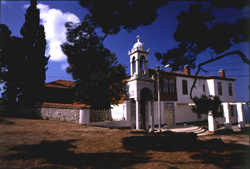 |
This is one of the monasteries on
the largest island. Over the years, the monasteries
have housed many exiles, giving the islands the
name "Isles of Exiles." |
These 9 islands are said to be some of the most
beautiful areas in all of Constantinople. Situated
on an archipelago, these
islands house 2 monasteries and a convent, as well as
several small copper mines and fishing villages.
Several of the Patriarchs of Constantinople are buried
here. A fisherman can give you a ride over to the
islands for very little, making it a nice day-trip.
Galata
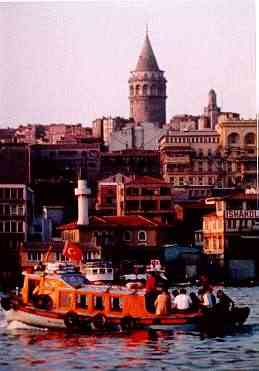 |
A view
of the Galata Tower. |
History: Galata began as a semi-independent
Genoese merchant colony in 1261, when the Byzantine
emperors approved the district. These Genoese built
many walls and fortifications around the city as
protection. Once this city center became too
crowded, many of the richer merchants and upper class
moved out into the countryside north of the city, building
huge mansions and houses. Galata is a huge
commercial center with numerous markets. The markets
are mostly divided according to what is sold, such as the
fish market or the produce market. One of the best
places to visit is the Galata Tower, or the Tower of
Christ, which is one of the main fortifications of the
city. The top level of the tower commands a view
over the entire area, including the Galata Bridge, and the
Strait of Bosphorous. |